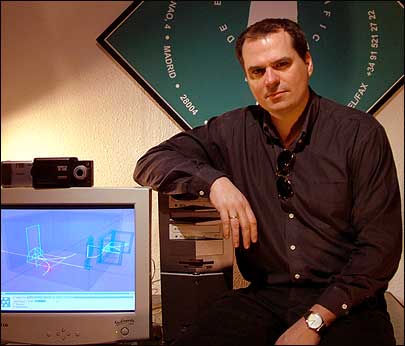Although De Espona Infografica has more than 20 years of experience working with three-dimensional computer graphics for movies, videogames and computer simulation, the Madrid-based firm admits it is a novice in the world of radio frequency identification and artificial intelligence. Even so, the 3-D computer graphics developer believes its approach could spur the development and deployment of robots and IT systems capable of interacting with physical objects in the real world.
The company’s 3DFORM-ID concept system would use the memory of an RFID tag to contain data describing the three-dimensional form and physical properties of the object to which the tag was attached. Equipping a system with an RFID reader would allow it to detect the object and download its 3-D data, as well as that of any surrounding tagged objects, to re-create a three-dimensional scene identical to the detected environment. The system could also make dynamic three-dimensional predictions concerning the detected objects.

Espona believes such a system could enable multiple applications. For example, with everyday objects in a home fitted with 3DFORM-ID tags, domestic robots would be able to help people clean and maintain their homes. In another application, the 3-D information on tagged objects could be used to help packaging and shipping companies reduce the costs of packing, and to optimize the number of containers being transported, thereby lowering transport costs. De Esposa Infografica has already registered a patent for its 3DFORM-ID concept for use in a number of applications, including automated driving. Details of the applications can be found here.
With the 3DFORM-ID system, object information is stored not centrally, but locally, on RFID tags. “Including three-dimensional intelligence in an RFID-based system means a drastic decentralization,” says Jose Maria de Espona, CEO at De Espona Infografica. “Any object can be understood totally by any other object equipped with readers and the computing capacity to run the 3DFORM-ID software, despite its location or whether or not its has a network connection.”
RFID also provides a way for computers to understand objects around them without utilizing video cameras, which generate far greater amounts of data that must then be stored and processed, than a system using data collected from each object’s tag.
However, the megabytes or gigabytes of 3-D data stored on the tags would far exceed the capacity of current RFID technology. A fully operative 3DFORM-ID tag would have to contain several different levels of data (LOD)—that is, different levels of 3-D model resolution, according to how near the tagged object is to an interrogator.
“Current RFID tags don’t suit our needs, not only for the huge memory requirements, but because an ideal 3DFORM-ID system would be multifrequency-capable for communication at different distances, and in different situations,” says De Esponsa. Enabling such large data downloads from tag to reader would also require a new generation of RFID interrogators operating with multiple frequencies and protocols, and with software management to enable different degrees of tridimensional data about a tagged object to be accessed.
“RFID interrogators or readers must be capable of using a ‘cascade’ solution to manage huge amounts of information coming from tridimensionally identified objects,” De Esponsa explains. “According to different interrogator requests, the interrogation protocol must start downloading the lowest-resolution LOD model from the ID, then—and only after loading a previous lower-resolution LOD—proceeding with a higher-resolution LOD download, and so on until arriving at a critical distance, interaction or amount of data. And then, maybe, the interrogator must jump to another more direct, higher-capacity technology, such as 3G, Wi-Fi or WiMAX or a wired conection.”
Some simple 3DFORM-ID systems, however, may be possible using RFID tags and readers available today. “Current RFID tags are in the 64-kilobyte memory capability range, and this allows very crude 3-D form definitions of the real objects—practically only their maximum bounding volume,” says De Esponsa. “Therefore, their 3DFORM-ID usage is limited to such applications as managing containers.”
De Esponsa is seeking partners to develop and promote the use of 3DFORM-ID. He is also working to establish a 3-D standard format for the device, as well as the creation of a central database of 3-D objects concerning real objects using this technology. “The full implementation of 3DFORM-IDs in RFID will require a huge and expensive effort to develop a new generation of RFID,” he says, “with megabyte or gigabyte memories and multifrequency capabilities.”

